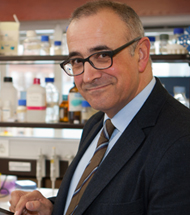Interview with Ignacio López-Goñi, director of the Natural Science Museum
Ignacio López-Goñi, director of the Museum of Natural Sciences, has a PhD in Biology and Full Professor of Microbiology. He combines his teaching duties at the School of Sciences with an intense activity of knowledge dissemination and scientific dissemination.

PHOTO: Manuel Castells
In this interview, he brings us closer to this project of Horizon 2020, "a university museum that educates, researches and teaches through science and nature".
How did the University's Museum of Natural Sciences come about?
Actually, what we now call the Museum of Natural Sciences is not something new. It includes the collections and donations of animals, plants and minerals that, in a small part, have been exhibited to the public at Hexagon Building, since 1998.
Many may not know that 95% of the museum's pieces come from the work of research, conservation and maintenance of the zoological and botanical collections, which has been carried out by the department of Environmental Biology, for more than 60 years.
What characteristics does this museum have that make it different from other Natural Science museums?
I would highlight three characteristics of its privileged location that, in my opinion, make it unique and original. Firstly, that it is in Navarra: biological diversity and natural wealth is one of its identifying features, a mosaic of landscapes that are home to countless animal and plant species, and turn the territory into a complete showcase of nature. Secondly, in a unique campus in Spain, which sample our commitment to the environment, the defense of biodiversity and the care of creation. The campus is much more than a garden, it has to be part of the museum. And thirdly, in a University where the three pillars of project converge: a university museum that educates, researches and teaches through science and nature.
You speak of the university environment, but is this project something exclusive to the School of Sciences?
Not at all. The museum is not just a showcase, it is a university project of research, Education and knowledge dissemination scientific. One of our first objectives is to continue promoting the joint work with other Schools and centers such as the School of Communication, Education and Psychology, the School of Architecture... We already have a program educational for schoolchildren with the Museum of Art and we are in contact with teachers from Degree in design to prepare a new itinerant exhibition . In addition, we also want to collaborate with the group of Environmental Volunteers.
What values does the museum want to transmit?
We want to help understand the human being of the 21st century. We believe that the answer can only come from a transdisciplinary approach, which takes into account the relationship between human beings and their environment, the planet they inhabit. The contemplation and admiration of nature leads us to a commitment to the Earth and our fellow human beings. Our mission statement is also to show that science is at the service of nature and human beings, from a double perspective: the conservation of nature and the defense of biodiversity, and the value of scientific research at the service of society.
How does a natural science museum conduct research?
The museum allows to exploit efficiently the research made from the existing collections, as well as to better conserve those resulting from future research. The museum allows the identification and description of new species of animals and plants. It is also a repository of "backup copies" of many living beings that cannot be replaced, so that they can be studied even if they disappear. On the other hand, programs of study based on the collections have applications in fields such as ecology, identification of threatened organisms, conservation biology, evolutionary programs of study or related to management and biodiversity conservation or climate change.
